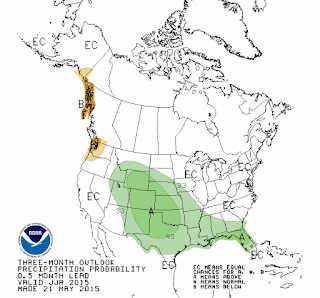The above average SSTs normally begin around the spring/summer and if they last til the winter, it can alter the Earth's climate (these are what we call teleconnections). The more prevalent teleconnections occur in the winter months. In the United States, during the winter months an El Nino normally (each episode is different) causes:
1. Wetter conditions in Southern California and the Southwest
2. Warmer conditions in the Pacific Northwest
3. Wetter and cooler conditions in the Southeast
The Climate Prediction Center (CPC) just released the current ENSO's evolution earlier this week. CPC has issued an El Nino Advisory. Meaning, there is a 90% chance El Nino conditions will continue through the summer and an 80% chance of it lasting through the winter. Here are the latest SST anomalies:
As you can see, there is an extensive range of above normal SSTs. They are about 1C above normal, which is pretty strong for this time of year. There is also fairly negative Outgoing Longwave Radiation, which enhances the convection (thunderstorms) and precipitation. Lastly, there are anomalous low level (850 hPa) westerly winds present. Overall, most of the models predict El Nino will persist throughout this year. If it does, it will give some relief to California because it usually causes decent rainstorms there.
As for the summer outlook, CPC predicts normal temperature and precipitation conditions for most of NC (Fig 2).
 |
This May has been kind of dry with just 2.46" of rain thus far in Raleigh. A lot of NC is in a slight drought and hopefully it will not worsen too much. However, if El Nino conditions continue, the slight drought should be relieved. I personally like El Nino conditions because it makes for an interesting winter. We shall see.
Cheers,





